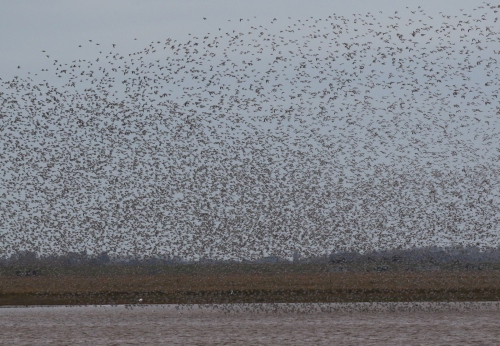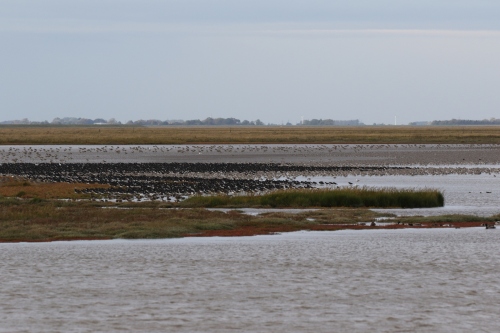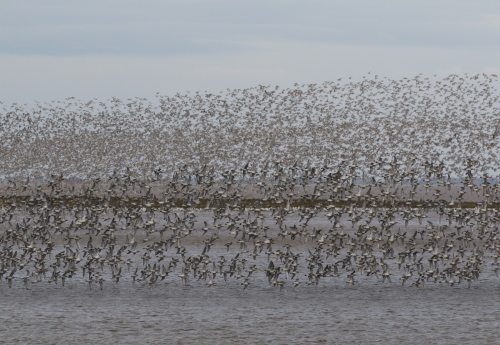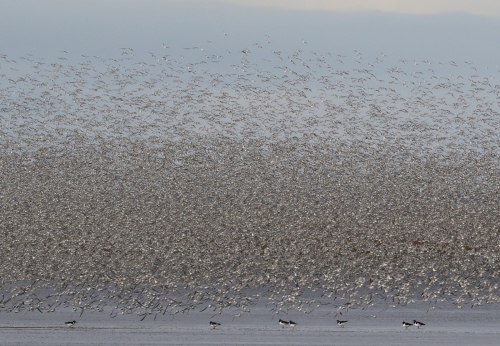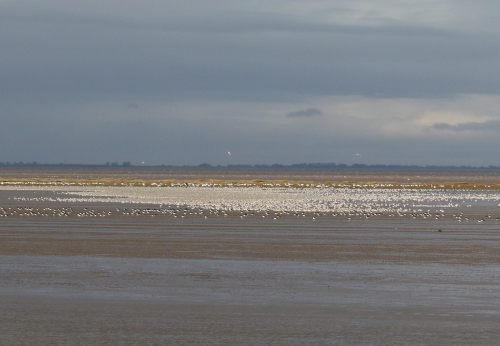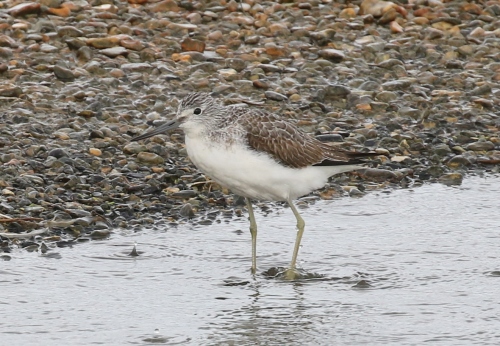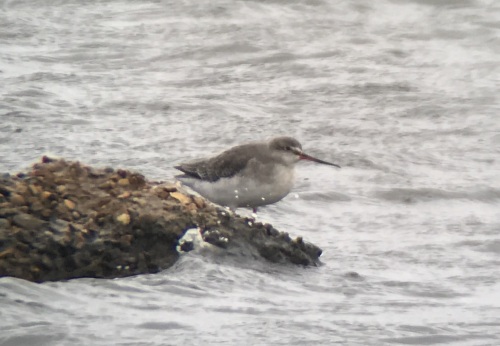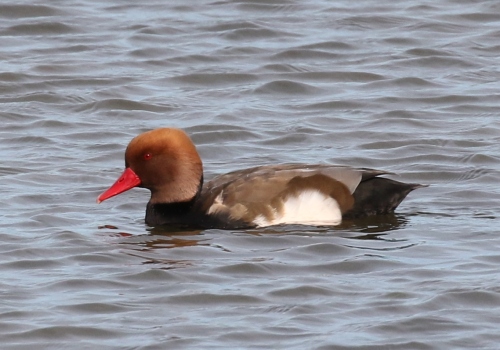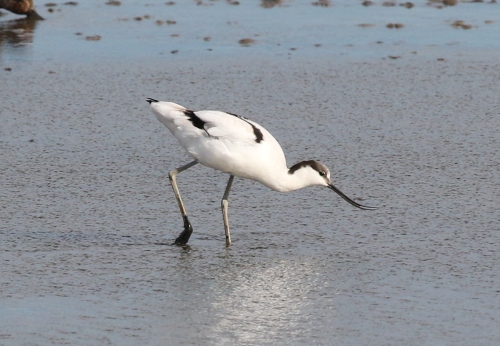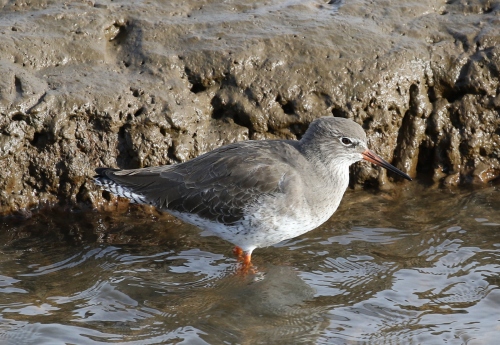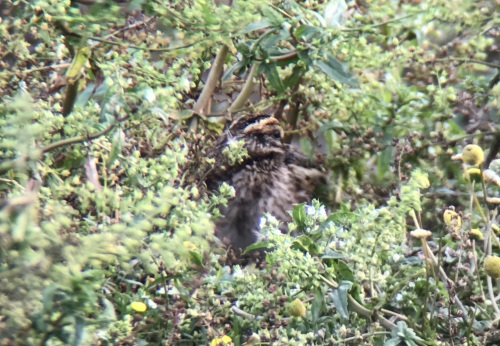Day 4 of a four-day Autumn Tour today, our last day. It was meant to rain all day today and, although it was wet at times, it was nowhere near as bad as we might have feared based on the forecast. The wind was very light in the morning, but swung round to the north and picked up a bit more in the afternoon.
With the forecast of rain, we headed over to Cley first thing, so we could take shelter in the hides. But when we got there, it wasn’t raining, so we decided to make the most of it and drove round to the beach first.
As we walked along the shingle, a large flock of
Linnets came out of the weedy vegetation the other side of the fence accompanied by
Goldfinches and followed by a number of
Meadow Pipits. We were looking for a
Snow Bunting, which had been here for a few days, but there was no sign of it with these other birds here.
Continuing on to where the vegetation grows out over the open shingle, we walked through amongst the sparse tall weeds around the edge. A couple of
Skylarks came up from the edge of the grass and disappeared off towards the Eye Field, and then a
Wheatear flew out and landed on a lump of concrete on the beach. It was looking rather bedraggled, presumably from the wet vegetation, and stood there watching us.
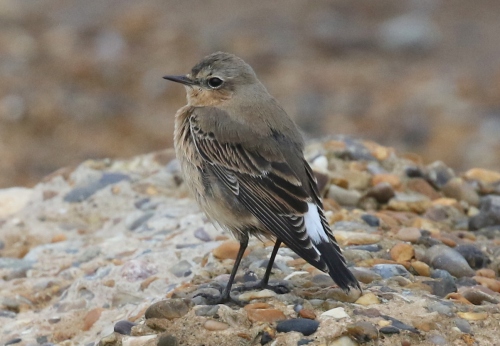
Wheatear – this bedraggled individual was feeding out on the edge of the beach
Just a couple of metres further along, we noticed something moving on the shingle right in front of us, as we almost trod on the
Snow Bunting. It was feeding quietly on the top of the beach, where some low weeds were growing through the stones.
Snow Buntings are often very tame, coming from places where they probably are not used to seeing people, and this one was very accommodating. It was a male, but rather dark grey and brown, an
Icelandic Snow Bunting of the
insulae subspecies.

Snow Bunting – feeding quietly on the top of the shingle ridge
A large flock of
Ringed Plover flew round over the sea and landed back on the beach some distance further up ahead of us. Looking through the scopes, we could see there were a few
Dunlin with them too, but the birds were remarkably hard to see on the stones and part of the flock was hidden from view over a rise in the beach.
There was quite a bit of activity over the rather calm sea this morning, so we stood for a while and scanned out over the water. A steady stream of
Gannets came past, mostly flying east, a variety of different colours and ages, from dark grey-brown juveniles, to the white adults with black-tipped wings, and various stages in between.
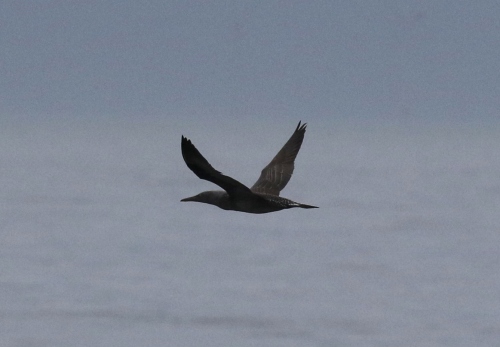
Gannet – several dark grey juveniles were among those flying past
Several
Red-throated Divers were swimming on the water and we had a closer look at both an adult still mostly in breeding plumage and one already in grey and white winter attire. A
Shag flew west along the shoreline, past us.
At this time of year, birds are arriving from the continent for the winter and there was a nice selection of wildfowl coming in over the sea today. A steady stream of small lines of
Brent Geese flew past low over the sea, coming back from their breeding grounds in Russia, and we saw several flocks of
Wigeon and
Teal too. Two
Red-breasted Mergansers flew past just off the beach together with a couple of
Teal and a few
Common Scoter went past further out.
Looking inland, a
Marsh Harrier was standing down on the short grass on the edge of North Scrape, but there didn’t seem to be much else on there today. A
Common Snipe and two
Redshank were feeding on Billy’s Wash. Remarkably, the rain was still holding off – despite it being forecast to rain all morning – so we thought we would push our luck and head round to the East Bank for a walk. A pair of
Grey Seals was bobbing in the water just off the beach, watching the people walking past, as we made our way back to the car.
The East Bank car park was quite full, so we parked at Walsey Hills instead. We stopped to have a look at Snipe’s Marsh first. We could see a
Little Egret feeding on the mud amongst the cut reeds, but there didn’t appear to be any waders here at first. However, a careful scan around the edges eventually produced the hoped for
Jack Snipe, well spotted by one of the group, asleep in the reeds on one side.

Jack Snipe – showed well, sleeping on the edge of reeds
We had a good look at the
Jack Snipe through the scope. It woke up at one point and we could see its bill, thicker and shorter than a
Common Snipe. We could also see the distinctive head pattern. A
Water Rail ran across the mud the other side but disappeared into the reeds before anyone could get onto it. Helpfully it re-emerged a little later and walked back the other way.
There seemed to be some smaller birds on the move this morning, and we could hear
Chaffinches calling overhead as we stood by Snipe’s Marsh. One or two
Bramblings gave their wheezy calls too. A
Cetti’s Warbler was singing from time to time from the reeds and a
Bullfinch was calling over by North Foreland wood.
There looked to be some darker clouds approaching now, so we decided to have a quick look in the trees at Walsey Hills. As we walked along the footpath, we could hear
Robins and a
Chiffchaff calling. We had been lucky with the weather up until now but at this point it finally started to rain. We walked up to the top to have a look in the trees, but beat a hasty retreat.
It was time to head for the hides and get out of the weather. Having been to the Visitor Centre to get our permits, we walked quickly out along the boardwalk and straight into Dauke’s Hide. As soon as we got inside, someone very kindly pointed out a
Kingfisher, which was perched down on the mud right in front.
The
Kingfisher was wrestling with a stickleback. It had dropped it on the mud, but hopped down and picked it up and proceeded to beat it against the small mound it was standing on. It dropped it again and stood looking down at it, before finally picking it up once more and eating it.
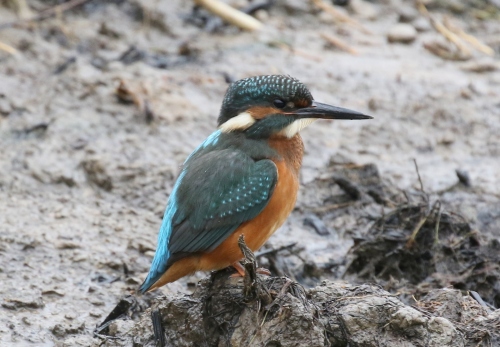
Kingfisher – was wrestling with a stickleback on the mud in front of the hide
We enjoyed stunning views of the
Kingfisher – it kept coming closer to the hide, perching on a post in the channel just in front. Eventually, it flew off up the channel but a few minutes later it was back again on its favourite post.
Dragging our attention away from the
Kingfisher, we noticed a
Little Stint with ten
Dunlin on Whitwell Scrape. It was hard to see properly from Dauke’s, particularly to get an angle for the scopes, so we hurried round to Avocet Hide for a closer look. The
Little Stint was noticeably smaller than the accompanying Dunlin, with a shorter bill and cleaner white underparts.
Little Stints have been thin on the ground this autumn. The passage of juveniles through here way outnumbers adults, so it could be that they have had a poor breeding season, or perhaps just the persistent westerlies mean that the numbers reaching here have been low. Either way, it was nice to catch up with one today.
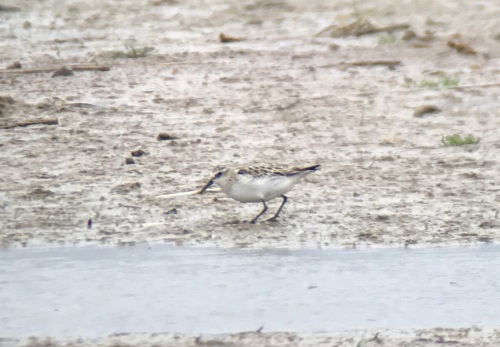
Little Stint – a juvenile with 10 Dunlin on Whitwell Scrape
The
Dunlin and
Little Stint were spooked by something and flew back across to Simmond’s Scrape, so we went back round to Dauke’s Hide. The
Kingfisher had disappeared, but a
Water Rail was now running around down in front of the hide, giving great views.
There were a few other waders out on Simmond’s Scrape today, including a
Curlew, and a couple of
Ringed Plovers. A flock of
Golden Plover dropped in. Several
Black-tailed Godwits were feeding in the deeper water on Pat’s Pool.
There are lots of ducks back for the winter already, mainly
Wigeon and
Teal, along with a few
Shoveler. Looking through them carefully, we found a single
Pintail, a drake starting to moult out of eclipse plumage. There was a big RSPB group in Dauke’s Hide today, so there was nowhere for us to sit. They had given up looking at the birds though and had settled in to eat their lunch. Eventually, all the loud discussions about double cherry bakewells and their different home made chutneys started to make us hungry, so we decided to head somewhere more appropriate to eat our lunch. Thankfully, the rain had now stopped again.
The shelter round at the beach car park was the perfect spot, out of the wind, which had now swung round to the north. After lunch, we had a quick look out at the sea. There were still lots of
Gannets moving, plus one or two plunge diving just offshore now. Several
Sandwich Terns were patrolling up and down. A
Razorbill flew past, and a
Guillemot was diving, out on the sea just off the beach.
There had apparently been an arrival of
Blackbirds and
Robins overnight, with a few seen around Cley first thing, so we thought we would see if there was any sign of activity down at Kelling Water Meadow. However, the lane was disappointingly quiet, just a few
Chaffinches in the trees. Perhaps it had been too disturbed during the morning to hold anything here. There were lots of
Pheasants in the fields, and
Red-legged Partridges calling – this is a shooting estate after all.
Rooks and
Jackdaws were flying around the trees or on the hillside beyond the Water Meadow.
Down at the pool, the first thing we noticed were the gulls. There were quite a few
Black-headed Gulls, but one young bird immediately stood out. It was a young
Mediterranean Gull, a 1st winter. Continuing down to the corner for a better look, we found another two
Mediterranean Gulls on here as well, a second 1st winter and also a 2nd winter. There were a few
Herring Gulls,
Lesser Black-backed Gulls and
Great Black-backed Gulls too.
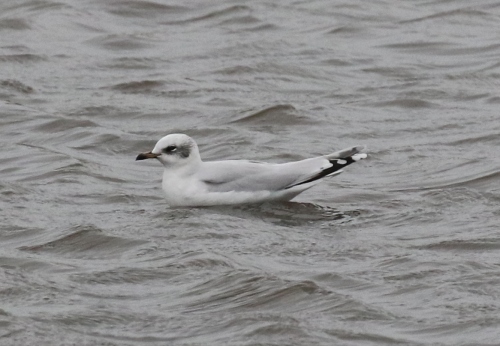
Mediterranean Gull – one of three immatures on the Water Meadow this afternoon
It was rather exposed when we got out of the shelter of the lane, and it was spitting with rain again. With the lack of any obvious sign of any migrants, we decided to head somewhere more sheltered.
On our way back west, we had a look up at the church tower and could see the
Peregrine back again. It didn’t look particularly happy though, facing in to the wall and hunched up, presumably sheltering from wind & drizzle. We got it in the scope and had a good look at it – eventually it even turned its head to look round.
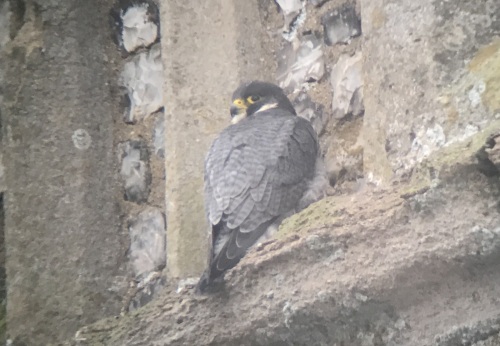
Peregrine – back on the church tower, sheltering from the wind & rain
Wells Woods seemed like a good place to finish, where we could get out of the northerly breeze. Several
Little Grebes were diving out on the boating lake as we passed. We made our way in and up to the Dell, before we came to a tit flock. One of the first birds we got our binoculars on was a
Yellow-browed Warbler. It was feeding in a small birch and we all managed to get a good look at it. A
Goldcrest flew into one of the low bushes right next to us to feed, giving us a chance to appreciate just how small they are.
Their glipping calls alerted us to some
Common Crossbills in the pines and we quickly realised they were right above our heads. We watched them flying down to the lower branches to find cones, before taking them higher up to deal with. They have been rather few and far between over the last year or so here, so it was great to see them and quite well.
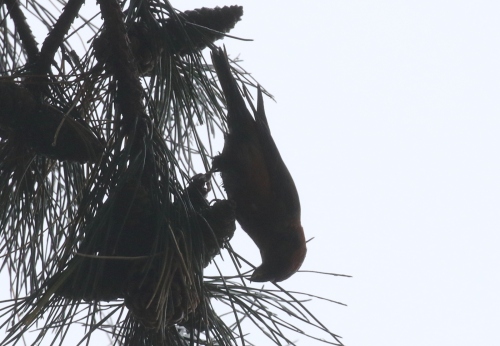
Common Crossbill – feeding above our heads in the pines by the Dell
We followed the tit flock as it made its way through the trees for a few mins. As well as all the
Long-tailed Tits,
Blue Tits,
Great Tits and
Coal Tits, we could hear
Treecreeper and
Chiffchaff calling. Eventually, the
Long-tailed Tits led the other high up into the pines and they disappeared.
It was a productive few minutes, and a nice way to end the tour, in Wells Woods. We got as far as the drinking pool, but it was time to head back, with people wanting to get away quickly. It had been a very good four days too, with a nice selection of different Autumn birds.




























